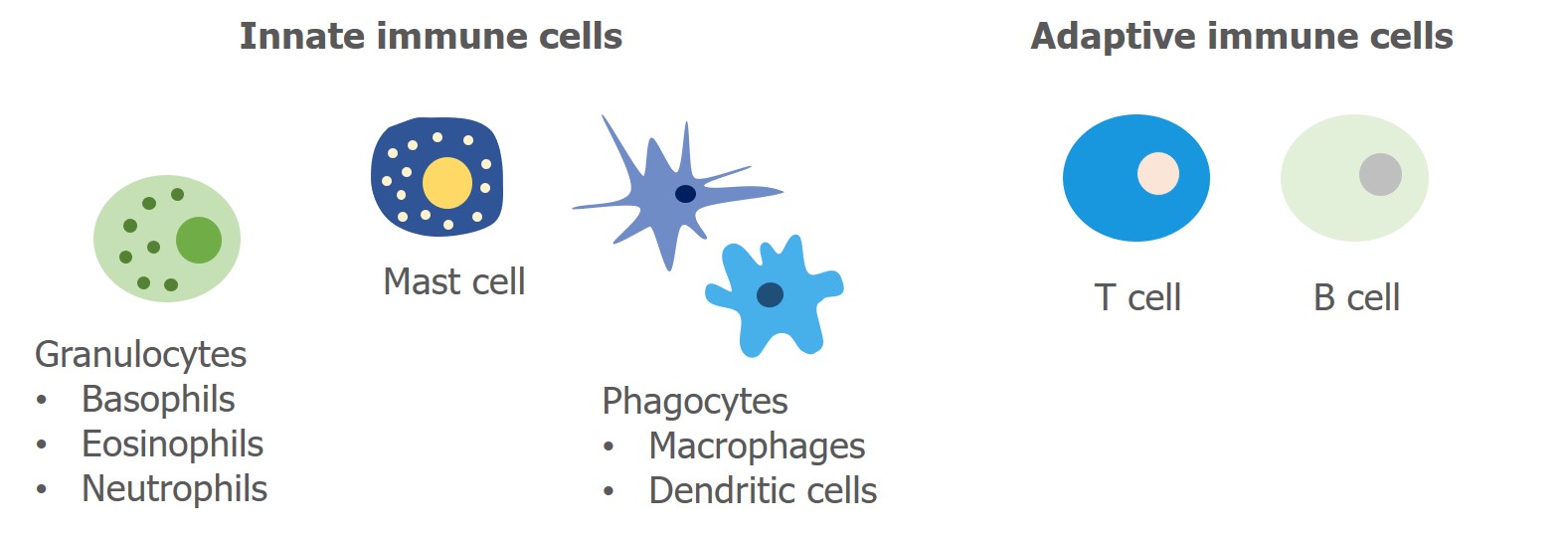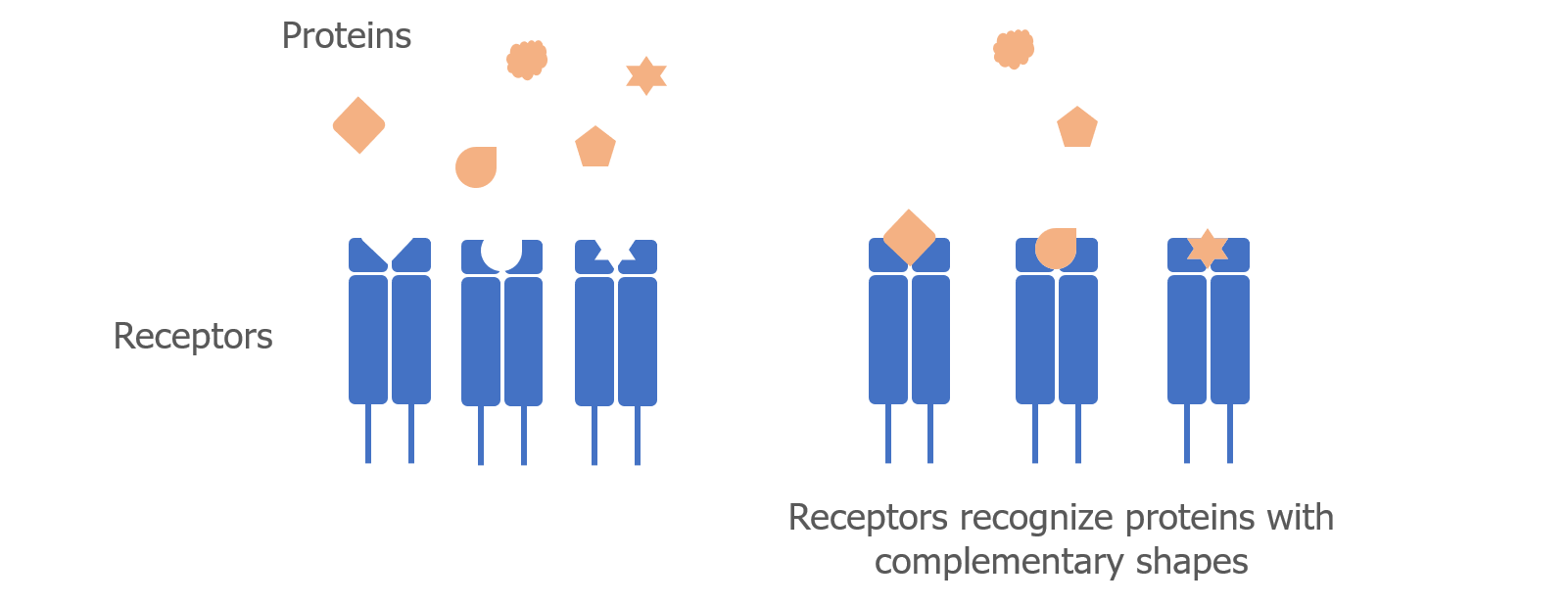Every day, potentially harmful bacteria and viruses (also called pathogens) try their best to infect us. Our immune system works tirelessly to defend against these attacks by preventing infection and killing pathogens before they cause harm.
The immune system is actually made up of many different parts, including:
- Physical and chemical barriers (skin, lining of mouth and nose, mucus, enzymes)
- Immune cells (white blood cells or leukocytes with specialized functions)
- Cytokines (molecules that help immune cells communicate with each other)
- Antibodies (molecules that recognize foreign pathogens)
When a pathogen gets past the physical and chemical barriers of the body, the immune cells are quickly called to action. Once activated, the immune cells produce molecules called cytokines and antibodies. By creating these molecules, immune cells are able to communicate with each other and destroy the invading pathogen.
The next section explains a bit more about the different types of immune cells in our bodies and the important jobs they have.
Immune Cells
Immune cells are specialized white blood cells (also called leukocytes) that circulate through our blood vessels and settle in many of our tissues and organs. They are on constant watch for anything that appears to be foreign and might be considered a threat to our health.
Immune cells are divided into two main groups—innate immune cells and adaptive immune cells. Within each of these groups are several subsets of cells that have specific jobs. Much like soldiers in a military operation, immune cells use different tactics and communication strategies to overpower the enemy.

Innate immune cells
Innate immune cells act as the first responders to infection. They attack and eliminate many pathogens using basic methods that are harmful to cells. Different types of immune cells use different techniques. For example, cells called granulocytes (which include basophils, neutrophils, and eosinophils) kill pathogens by releasing toxic molecules. In contrast, other cells called phagocytes (which include macrophages and dendritic cells) ingest—or eat—pathogens to prevent them from causing damage to normal healthy tissues in the body.
Adaptive immune cells
Adaptive immune cells recognize specific pathogens and work together to create a customized immune response. Adaptive immune cells are either T lymphocytes (T cells) or B lymphocytes (B cells). These lymphocytes were named after the place in the body where they mature—T cells mature in the thymus and B cells in the bone marrow. T cells and B cells play major roles in autoimmunity and celiac disease and will be discussed in more detail in later sections.
How Do Immune Cells Detect Pathogens?
Immune cells obviously don’t have eyes or ears to see or hear trespassing pathogens. What they do have are proteins called receptors that interact with other proteins. The receptors have unique shapes that recognize proteins with complimentary shapes—similar to a lock that can only be opened by a specific key.

An immune response begins when an immune cell receptor (the “lock”) interacts with a protein from a pathogen (the “key”). A protein that is recognized by an immune cell receptor and triggers an immune response is called an antigen.
The receptors on innate immune cells recognize common proteins that are found on several types of pathogens, which gives them the flexibility to recognize more than one type of invader.
In contrast, the receptors on adaptive immune cells (T cells and B cells) recognize unique proteins that only certain types of pathogens have. This allows the immune system to “remember” a specific type of pathogen and to quickly begin an immune response if the pathogen infects the body again.
After the pathogen has been removed, the immune cells become deactivated and return to their normal state.
Many different diseases are caused by a malfunction of the normal immune response. This can happen in several ways. For example, immune cells may:
- Fail to recognize a certain pathogen, which leads to chronic infection.
- Mistakenly recognize a normal protein, which results in autoimmune disease.
- Fail to “turn off” the immune response, which leads to chronic inflammation.
The next section will describe in more detail what goes wrong in autoimmune disease.
GLOSSARY
Adaptive immune cells – Immune cells that recognize specific pathogens. Allow the immune system to “remember” pathogens in case of future infection.
Antibodies – Y-shaped proteins that recognize foreign pathogens. Made by B cells. Also called immunoglobulins.
Antigen – A protein that is recognized by an immune cell receptor and triggers an immune response.
Autoimmune disease – May occur when the immune system mistakenly recognizes a normal protein in the body as an invader and creates an immune response.
B cell – A type of adaptive immune cell. Also called B lymphocyte.
Cytokines – Small proteins that are made and released by immune cells. Allows cells to send signals and provide instructions to other cells.
Granulocytes – A type of innate immune cell that releases toxic molecules to fight infection.
Immune cells – Specialized white blood cells (also called leukocytes) that fight infection.
Innate immune cells – Nonspecific immune cells. Recognize many pathogens. First responders to infection.
Leukocytes – Specialized white blood cells (also called immune cells) that fight infection.
Lymphocytes – Adaptive immune cells. Can by B or T lymphocytes.
Pathogens – Bacteria and viruses that can cause disease.
Phagocytes – A type of innate immune cells that ingests (or eats) pathogens.
Receptor – A protein that is located on the surface of a cell and interacts with other proteins. Receptors act as the “locks” that recognize specific pathogen “keys”.
T cell – A type of adaptive immune cell. Also called T lymphocyte.
Share this Post
